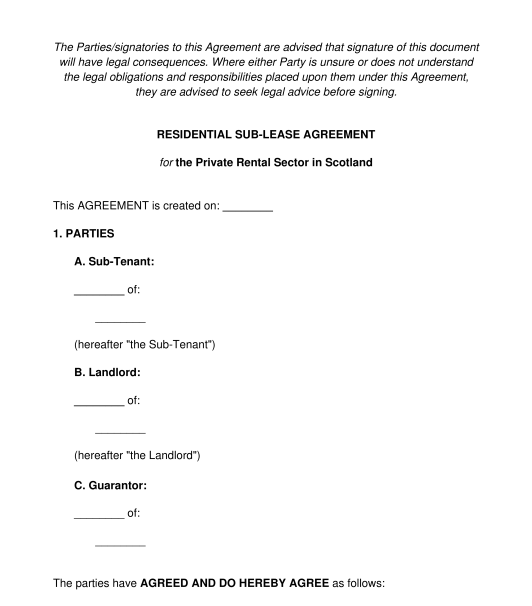 24/09/2025
24/09/2025

Answer a few questions and your document is created automatically.

Your document is ready! You will receive it in Word and PDF formats. You will be able to modify it.

 24/09/2025
24/09/2025
 Word and PDF
Word and PDF
 15 to 22 pages
15 to 22 pages



A tenant who is already renting a private residential property can use a sublease agreement to grant a tenancy to another tenant. The new tenant becomes a subtenant and the existing tenant will be the sublandlord. The property will be used as a subtenant's home and main place of residence. This sublease agreement can be used in Scotland.
A different sublease agreement is available for use in England.
This agreement will be used for private residential properties and should not be used if the property is owned by the local council.
A lodger will occupy a room or a space within a property and the sublandlord will remain living in the rest of the property. A lodger agreement creates a common law tenancy, which is a contractual agreement between the owner and the lodger. A lodger agreement can be terminated with notice, as per the terms of the agreement.
A sublease agreement creates a private residential tenancy. The agreement will be open-ended meaning there is no fixed end date. In order to end a sublease agreement, a sublandlord must rely on particular grounds for eviction and must follow a prescribed process. Subtenants under a sublease agreement will have particular rights in accordance with the relevant housing laws.
Yes. If a tenant wants to rent a property to a new tenant under a sublease agreement, they must give the subtenant a written copy of all of the terms of the tenancy.
Before creating a sublease agreement, the sublandlord who is granting the new sublease must:
The parties may also wish to receive advice* before the agreement is finalised and signed.
The agreement will not be reviewed by a lawyer to ensure that the legal content applies to the personal situation of the parties. In order to receive advice about the particulars of this agreement before it is finalised, it will be necessary to instruct a lawyer. For this type of agreement, it is necessary to consult with a lawyer who is regulated by an approved regulator in the legal services sector. It is possible to search for a lawyer on the Law Society website.
The sublandlord of the sublease agreement will be a natural person. They must already have a tenancy agreement in respect of the relevant property. The subtenant will be a natural person.
The parties should be over the age of 16. The parties should have the legal capacity to enter into a contract. Legal capacity refers to a person's ability to make and understand legal decisions (meaning that they are of sound mind).
The sublease agreement will be open-ended, meaning it will not have a fixed end date. In order to end a sublease agreement, a sublandlord must rely on particular grounds for eviction and must follow a prescribed process.
The agreement should be signed by both parties. It is possible to sign the agreement electronically. The parties can choose to sign the agreement in the presence of a witness, to assist in proving the validity of the agreement. The parties may wish to seek advice about the contents of the agreement*.
After the agreement has been signed, the parties should retain a copy of the agreement containing the signatures of both parties. The subtenant may occupy the property in accordance with the terms of the agreement. The sublandlord should provide the tenant with a tenant information pack before their tenancy start date (by no later than the date the tenancy is due to start).
The agreement will not be reviewed by a lawyer to ensure that the legal content applies to the personal situation of the parties. In order to receive advice about the particulars of this agreement before it is finalised, it will be necessary to instruct a lawyer. For this type of agreement, it is necessary to consult with a lawyer who is regulated by an approved regulator in the legal services sector. It is possible to search for a lawyer on the Law Society website.
Whilst not mandatory, a sublease agreement can be witnessed, to help prove the validity of the agreement. Each party may therefore sign the agreement in the presence of a witness, who will then also sign the agreement. The witness should be an adult with capacity, who is not a party to the agreement.
If the sublandlord is providing an inventory, then this should be attached at the space provided at schedule 1 of the agreement. A property inventory will provide a summary of all the items (such as furniture and white goods) in the property and will note the condition of those items.
The sublandlord must follow set rules and a particular process in order to end the agreement. The notice provided will depend upon the duration of the agreement and the grounds relied upon. Information is available on the government website about this.
If the subtenant wishes to end the tenancy, they should provide written notice to the sublandlord and should provide at least 28 days of notice.
A sublease agreement will:
The following key legal provisions will be relevant to a sublease agreement:
You fill out a form. The document is created before your eyes as you respond to the questions.
At the end, you receive it in Word and PDF formats. You can modify it and reuse it.
Guides to help you
Sublease Agreement (Scotland) - Template - Word and PDF
Country: United Kingdom